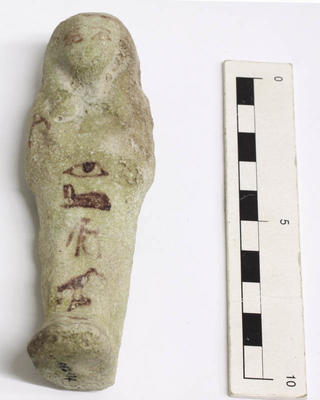Funerary Artefacts
Production date
1600 BC-1400 BC
Description
A collection of Egyptian funerary artefacts including three ushabti figures.
1.) A mummy figure made from green glazed limestone which has hieroglyphics marked on the front including an " eye ", " sphinx ", the "prince", "tahuti" and " justified " . The facial features are defined in the brown paint or dye. The figure has a brown thatched square marking on the back and is holding an agricultural implement. The figure is clad in funeral dress. 2.) A limestone mummy figure wearing traditional funeral attire with green/blue glaze. Black marks are outlined on the shoulders and across the back. The black marks on the front represent agricultural implements, which are held in the mummies hands. 3. A limestone boar headed figurine in a standing position with hands by its sides. The figurine probably represents a form of the sun god.
There are also six scarab beetle figures: 1) A soapstone figurine with a plain brown/white top with green and brown tinges around the sides. The base has a carved image and there is a hole through the front and back. 2.) A green scarab beetle with a carved relief image on base hole through the centre. 3) A soapstone white and blue scarab beetle with a carved relief image on the base. There is a hole through the centre. 4) A blue and white scarab beetle with carved relief spiral image on the base. Hole through the centre. 5) A limestone scarab beetle with white and green specks. Two arrow like shapes are on the base. There is a hole through the centre. 6) A scarab beetle with green and brown colouring which is attached to a card with printed details of the excavation at Abydos.
The collection also includes a turquoise blue glazed seal ring which features an image of the Lotus flower.
The collection also includes a brown stone Wedjat eye.
The collection also includes a stone seal with relief carving on the top and bottom surfaces. The top surface features several triangular shapes. A hole is bored through the centre of the stone orientated top to bottom.
The collection also includes a scaraboid, or scarab in the shape of a ram. The ram has a carved relief image on the base and a hole through the centre. A typed card with accompanying handwritten notes is included with the collection " EXCAVATIONS AT ABYDOS, UPPER EGYPT, 1907-8. DYNASTY XVIIIth B.C 1600 / ABYDOS: TOMB........ / " Ornamental seal device " is written on the card.
See full details

Public comments
Be the first to comment on this object record.